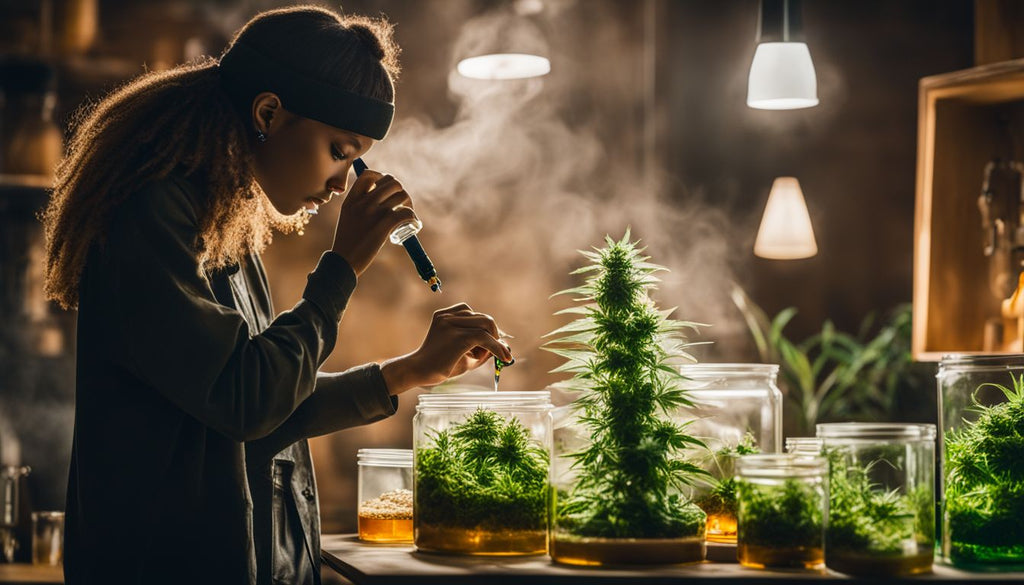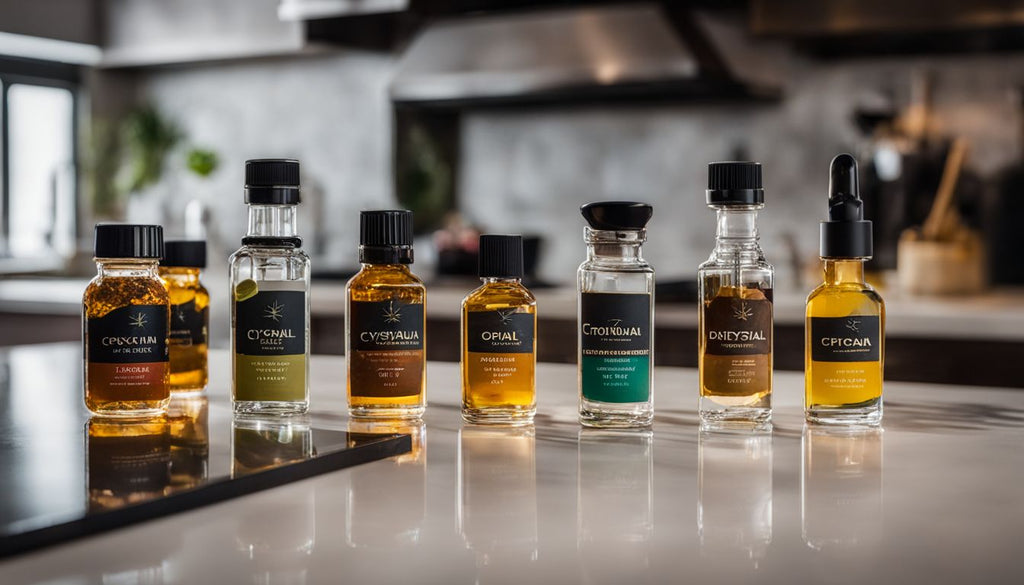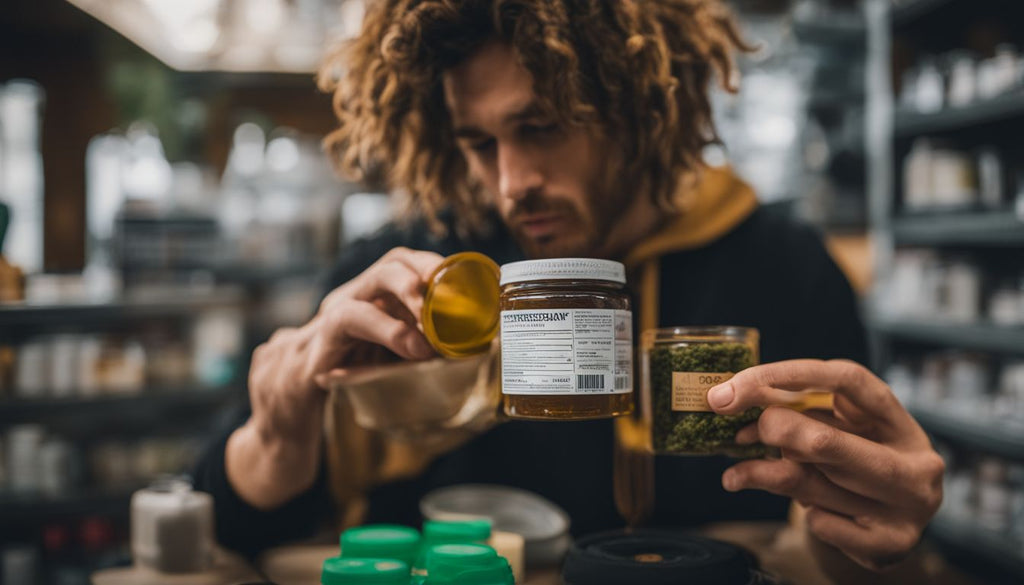Dab What Is: A Complete Guide to Marijuana Dabs and Dabbing

Many people hear about dabbing but don't really know what it is. Dabbing involves a potent form of marijuana called dabs, which delivers a strong dose of THC. This guide will take you through everything from what dabs are made of to how they're used safely.
Let's dive in!
Key Takeaways
- Dabs are concentrated forms of marijuana that come from extracting cannabinoids like THC and CBD using solvents such as butane. They have various forms including oil, shatter, budder, wax, and live resin which provide a potent high.
- The process of dabbing involves heating these concentrates on a hot surface and inhaling the vapor through a dab rig. This method has become popular due to its powerful effects and quick onset.
- Making dabs at home can be dangerous due to the use of flammable solvents like butane in the extraction process, posing risks of explosions and fires. Poorly extracted dabs might also lead to health issues from inhaling residual solvents.
- Dabbing carries health risks including impaired memory and coordination, increased heart rate, respiratory problems, anxiety or paranoia. It may also lead to cannabis use disorder due to the high levels of THC in concentrates.
- Seeking professional help for cannabis use disorder is important. Options include cognitive - behavioral therapy (CBT), support groups like Marijuana Anonymous or Narcotics Anonymous, family therapy or outpatient programs tailored for overcoming addiction towards marijuana concentrates.
What are Dabs?

Dabs, a concentrated form of cannabis, are made by extracting cannabinoids such as THC and CBD from the plant using solvents like butane. This results in highly potent extracts like oil, shatter, budder, wax, and live resin that can be vaporized and inhaled for a powerful high.
Definition of dabbing and its origins

Dabbing refers to the process of inhaling vaporized cannabis concentrates, known for their high THC content. These concentrates, such as wax or shatter, are heated on a hot surface and inhaled through a dab rig.
This method delivers potent effects quickly, making it popular among experienced users. The term 'dab' originates from the act of touching, or "dabbing," a small amount of cannabis concentrate onto the rig.
The history of dabbing traces back to the 1970s but gained significant popularity in the early 2010s with advancements in extraction methods. Techniques like BHO (Butane Hash Oil) extraction allowed for purer and more potent forms of cannabis concentrates.
As technology evolved, so did the quality and variety of products available for dabbing, turning it into an intricate part of modern marijuana culture.
Explanations of what dabs are made of

Marijuana dabs, also known as cannabis concentrates, are made by extracting the potent cannabinoids and terpenes from the plant. This extraction process involves using solvents like butane or carbon dioxide to separate the psychoactive compounds from the plant material.
The resulting concentrate can take different forms such as oil, shatter, budder, wax, or live resin, depending on factors like temperature and pressure during processing. These concentrated forms of THC offer a more potent and immediate high compared to traditional marijuana consumption methods.
The process of obtaining dabs begins with selecting quality cannabis flowers rich in trichomes – small glands that produce cannabinoids and terpenes. Manufacturers then use solvents to extract these compounds from the plant matter while adhering strictly to safety guidelines due to the flammable nature of certain solvents used in extraction processes.
Different types of dabs (oil, shatter, budder, wax, live resin)

Dabs come in different forms: oil, shatter, budder, wax, and live resin. Oil dabs are sticky and runny, shatter dabs are solid and transparent, budder dabs have the consistency of soft butter, wax dabs are opaque and crumbly, and live resin dabs retain the plant's natural flavors. Each type offers a unique experience from the others. When dabbing these different forms, it's important to use proper techniques to maximize the effects.
How Dabs are Made and Used
To make dabs, manufacturers use a butane extraction process to concentrate the THC found in marijuana. They then heat up the concentrated extract using a dabbing rig or vaporizer equipment before inhaling it for recreational purposes.
Butane extraction process
The butane extraction process involves the following steps:
- Ground cannabis is packed into a tube.
- Butane is then forced through the tube, extracting THC and other cannabinoids from the plant material.
- The resulting liquid is collected and heated to evaporate the butane, leaving behind a concentrated cannabis extract.
Dabbing rig and vaporizer equipment

To dab, you require the right tools for the job. Here's a guide to the essential equipment:
- Dab Rig: A specialized water pipe used for vaporizing cannabis concentrates.
- Nail: This is heated to high temperatures using a torch or electric nail, and is where the concentrate is placed.
- Torch: Used to heat the nail to the required temperature.
- Carb Cap: Placed over the nail to regulate airflow and optimize vaporization.
- Dabber Tool: A small, often pointed instrument used to apply the concentrate onto the heated nail.
Safety and Health Risks of Dabbing

Dabbing carries potential health risks due to the high concentration of THC. Users may experience adverse effects such as impaired memory, difficulty thinking and solving problems, and an altered sense of time.
Side effects and potential risks
Dabbing can have some side effects and potential risks. These include:
- Impaired coordination and judgment
- Increased heart rate and blood pressure
- Respiratory issues such as coughing or wheezing
- Amplified feelings of anxiety or paranoia
- Potential for cannabis use disorder
- Risk of burns or explosions when making dabs at home
Dangers of making dabs at home

Making dabs at home poses serious risks due to the use of highly flammable butane gas in the extraction process. Improper handling can lead to explosions, fires, and severe burns. Inhaling residual butane from poorly extracted dabs can also cause respiratory complications and other health issues.
Moreover, without proper equipment and training, there is a high risk of contamination with toxic substances, leading to adverse effects on physical and mental well-being.
It's crucial for individuals to understand the potential dangers and seek professional assistance if they want to engage in dabbing. Seeking safe alternatives such as purchasing tested and regulated products from dispensaries or licensed suppliers can greatly reduce these hazards while ensuring a safer experience.
Addiction potential

Dabbing marijuana concentrates can lead to addiction due to the concentrated THC content, which can increase tolerance and dependence. Regular use of dabs may lead to symptoms of withdrawal when trying to stop using, indicating a potential for addiction.
Users should be aware of the addictive nature of dabbing and take necessary precautions.
Long-term heavy use can result in cannabis use disorder, similar to other forms of marijuana consumption. Seeking professional help is essential if experiencing difficulty controlling or stopping dabbing habits.
Treatment Options for Cannabis Use Disorder
Explore various therapy and support options available to help manage cannabis use disorder and consider seeking professional assistance for a tailored treatment plan. For more detailed information, continue reading the article.
Types of therapy and support available
Several therapy and support options are available to help manage cannabis use disorder:
- Cognitive-Behavioral Therapy (CBT): A type of talk therapy that helps individuals identify and change negative thought patterns and behaviors related to dabbing.
- Motivational Enhancement Therapy (MET): A counseling approach that aims to motivate individuals to change their behavior by helping them resolve ambivalence and increase motivation for treatment.
- Support Groups: Joining support groups like Marijuana Anonymous or Narcotics Anonymous can provide a sense of community and understanding from peers who have had similar experiences with dabbing.
- Family Therapy: Involving family members in the therapy process can provide essential support and help restore healthy relationships affected by cannabis use disorder.
- Outpatient Programs: These programs offer regular counseling sessions, group therapy, and educational workshops to help individuals overcome marijuana dependence while maintaining their daily routine.
Detoxification and residential treatment options
Detoxification and residential treatment options provide professional support for individuals struggling with cannabis use disorder. The treatment options available include:
- Medically supervised detox programs to manage withdrawal symptoms and safely remove THC from the body.
- Residential treatment centers offering therapy, counseling, and holistic support to address substance abuse issues.
- Support groups and peer - led recovery programs tailored to help individuals overcome addiction and maintain sobriety.
- Psychiatric evaluation and medication management for co - occurring mental health disorders.
Contact information for a drug rehab center.

If you or someone you know is struggling with cannabis use and needs help, reach out to a local drug rehab center for support. These centers offer various therapy options, detoxification programs, and residential treatment facilities to help individuals overcome cannabis use disorder.
You can find contact information for a drug rehab center in your area by searching online or reaching out to addiction helplines.
Treatment facilities provide professional care and support tailored to individual needs. They offer guidance on managing withdrawal symptoms, developing coping strategies, and addressing the underlying issues contributing to substance use.
Conclusion

In conclusion, understanding what dabs are and how they are made is crucial for anyone considering dabbing. Knowing the potential health risks associated with dabbing can help users make informed decisions about their consumption.
Seeking professional treatment and support services may be necessary for individuals struggling with cannabis use disorder. Additionally, practicing safe extraction methods when making dabs at home is essential to minimize potential dangers.
FAQs
1. What are marijuana dabs?
Marijuana dabs are concentrated forms of tetrahydrocannabinol, or THC, extracted from cannabis plants. They're known for their high potency and are used in recreational inhalation.
2. How is THC extracted to make dabs?
THC extraction for making dabs can involve several methods, but one common technique uses Butane Hash Oil (BHO). This process pulls out the psychotropic cannabinoid and concentrates it.
3. What equipment do I need for dabbing?
For dabbing, you’ll need a dab rig, which is specially designed to heat and vaporize the cannabis resin or oil. Some people also use vaping devices as an alternative method.
4. Is dabbing stronger than smoking marijuana?
Yes, because dabs are concentrated forms of marijuana extracts containing a higher amount of THC compared to regular marijuana smoke. This means the effects can be much more intense.
5. Can I extract my own cannabis oil at home for dabbing?
While it’s possible to extract your own cannabis oil using methods like BHO extraction, it's risky due to flammable materials involved and might not produce safe or effective results without proper knowledge.
























Leave a comment